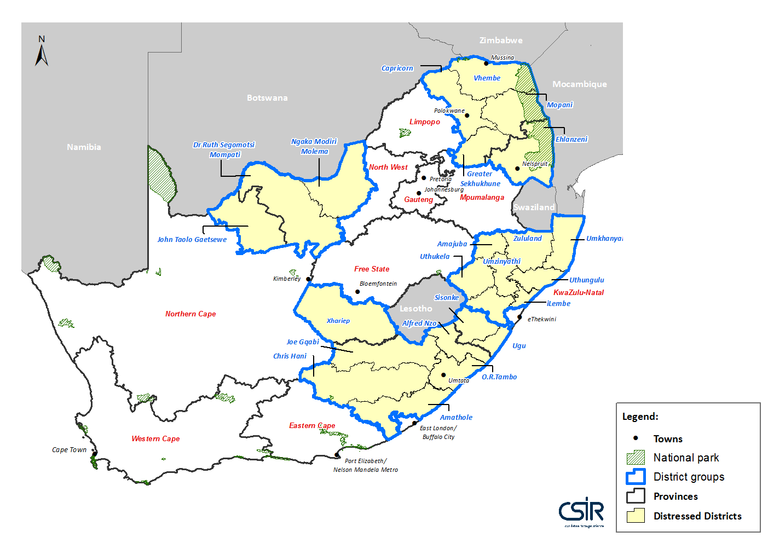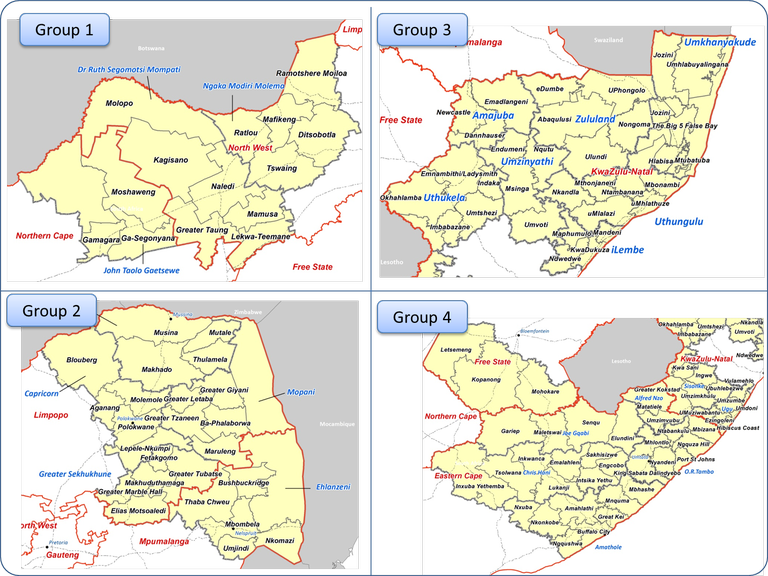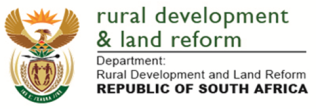“Rural District Demand Concentration Areas” comprises of settlement and area specific socio-economic development and service profiles for a selection of priority rural districts in the country. The profiles identify differentiated analyses for different settlement types, areas and household categories. It gives an indication of service demands, backlogs, areas of recent growth and continued concentration. It is primarily based on the stepSA Regional Profiler spatial indicators (developed from statsSA data sets) and has been developed by the DRDLR in collaboration with the CSIR, Spatial Planning and Systems during 2013.
The District Demand Concentration Areas (2013) have been developed by the DRDLR in collaboration with the CSIR, Spatial Planning and Systems team for 24 of the priority rural districts in the country. The analyses was based on, and further contributed to the spatial specific regional profiling capability developed through the CSIR and the national stepSA Collaborative Initiative (see more on the initiative on ABOUT). By 2013 the first 24 districts selected were calculated to be home to almost 18 million of South Africa’s rural residents, many of which are living in poverty. The district profiles have been developed in four regional clusters or groupings, often with adjoining (similar) settlement and land uses. All are experiencing high levels of poverty, service constraints, high unemployment and low levels of economic development and are therefore also described as distressed districts.


- Rural District Demand Concentration Areas GROUP 1: Northern Cape and North West
- Rural District Demand Concentration Areas GROUP 2: Limpopo and Mpumalanga
- Rural District Demand Concentration Areas GROUP 3: Kwa-Zulu Natal
- Rural District Demand Concentration Areas GROUP 4: Eastern Cape, Kwa-Zulu Natal and Free State
Rural District Demand Concentration Areas
In July 2011, Cabinet unveiled 12 implementation plans for immediate action by government. Action Plan 6 called for “Scaling up rural-development programmes including investment in rural areas and the revitalisation of smaller towns”. Responsibility for implementing Action Plan 6 was given to the Department of Rural Development and Land Reform (DRDLR) in conjunction with the Presidency. In response to Action Plan 6 – to adequately align the spheres of government and other state entities around core priorities for rural development – priority district municipalities have been identified as the focus areas for rural development.
The District Demand Concentration Areas (2013) have been developed by the DRDLR in collaboration with the CSIR, Spatial Planning and Systems team for 24 of the priority rural districts in the country.
What is evident is that major investment is taking place in the form of access to basic services. In many areas this is by far the biggest investment that will take place in a number of years, and as such provides the single biggest opportunity for the transformation of investment in support of government’s goals (as set out in the National Development Plan (NDP) of stronger regional economies and employment, increased quality of life and the cutting of carbon emissions by 2014. Through embarking on a much needed bottom-up approach with the relevant municipalities and provinces, the DRDLR, in collaboration with key national departments, has identified a number of key catalytic opportunities for rural infrastructure and economic transformation. This catalytic pathway inter alia, entails:
- A framework of rural economic transformation to fundamentally shift the nature of inter-governmental infrastructure investment and implementation support;
- The identification of priority settlements and areas for high impact (catalytic) and differentiated service, as well as economic infrastructure investment (Action Plan 6, as well as SIP11 and also informing SIP6). (For more information, see District Profiles above, as well as analyses framework for all clusters below:
- Cluster 1:
- Cluster 2:
- Cluster 3:
- The identification, validation and implementation support for a number of locally identified catalytic projects in the respective districts as a first tangible step in the process (For more information view projects in: Cluster 1; Cluster 2; Cluster 3: Cluster 4); and
- On-going implementation support to local municipalities and sector departments, identification of opportunities and priority settlements, as well as monitoring and evaluation of catalytic project implementation (Action Plan 6).
In order to enhance the impact of intensified government investment in these areas and on regional economies and the increasing number of dense settlements, the DRDLR also undertook a review of developmental realities and potential, as well as the opportunities and blockages associated with current government investment. This initiative also directly supports the Department’s responsibility in relation to SIP11 (Agri-logistics and Rural Infrastructure) and will also make a significant contribution to other role players and initiatives such as SIP6 (Integrated Municipal Infrastructure Project). During this process a number of key challenges and opportunities were identified. Challenges include:
- The clear emphasis by national departments in addressing remaining (and ever increasing) backlogs to provide communities with access to basic services (water, sanitation, electricity) and meet sector specific targets, as well as the reality that in numerous areas this investment will have to continue and be up-scaled in future;
- The financial feasibility of municipalities and the environmental implications and sustainability of increased demands for water and sanitation in growing and densifying rural settlements. This is placing a huge burden on government’s ability to provide services in a sustainable way, as well as being able to redirect funds towards job creation initiatives;
- The enormous challenge in creating sustainable livelihoods and jobs within a context of regional economic potential and the well documented capacity constraints in implementation; and,
- The way in which current funding and planning systems, as well as limited local capacity, marginalise direct municipal involvement, and the coordination of investment at a local level in support of economic transformation.
Opportunities include:
- Differentiated and more sustainable service delivery options are available and can be implemented to support ecosystems as well as municipal financial viability;
- The provision of basic services provides an enormous opportunity for sustainable job creation;
- Potential exists to support local economic transformation and agrarian reform through the identification of key opportunities and investment potential at a strategic regional scale – including opportunities associated with large scale infrastructure provision, agriculture and collaboration with regional role players within specific clusters/initiatives;
- The successful implementation and roll out of the Municipal Infrastructure Services Agency (MISA); and,
- The DRDLR mandate and coordination role allows the DRDLR to be ideally geared to put in place support for municipalities through local rural development desks.
These can facilitate a process to directly influence national investment and prioritisation, and set in place agreements to facilitate and coordinate implementation for enhanced impact on a local scale, thus creating people-centred rural economic transformation.
Project team:
DRDLR: Clinton Heimann, DDG Leona Archer
CSIR Built Environment:
Elsona van Huyssteen, Johan Maritz, Jo-Anne Chauvet, Gerbrand Mans, Mawande Ngidi, Cheri Green, Willemien van Niekerk, Alize le Roux, Maria Coetzee, David McKelly, Andre Breytenbach, Pierre du Plessis, Nontembeko Dudeni-Tlhone, and Renee Koen
CSIR Meraka:
Koenrad Wessels
EDD:
Damon Mathfield, Wendy Maphira
For inputs, comments feedback, contribution:
DRDLR regional officers, Directors, 23 District Municipality Representatives, Sector Department Representatives including: Department of Agriculture, Forestry and Fisheries, Economic Development Department, Co-operative Government and Traditional Affairs, Department of Human Settlements, Department of Public Works, and Department of Water Affairs, as well as the Presidential Infrastructure Coordinating Committee.
For collaborative platform and spatial data investment:
CSIR on-going investment in GAP, Settlement Typology, DST investment stepSA, Range of projects that established spatial data and analyses base line i.e. NPC Diagnostic Report, Spatial Planning Working Group
For more information on the socio-economic spatial indicators used: click here, on the project and project findings, click here or contact:
Clinton Heimann, DRDLR
cheimann@ruraldevelopment.gov.za
Elsona van Huyssteen, CSIR
evhuyssteen@csir.co.za
Johan Maritz, CSIR
jmaritz@csir.co.za



